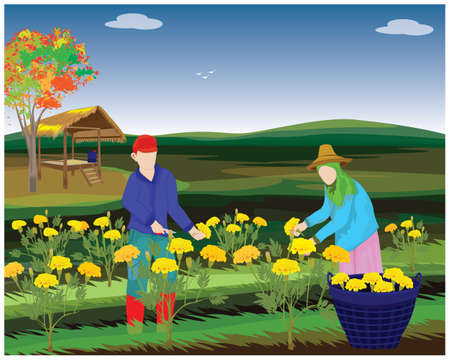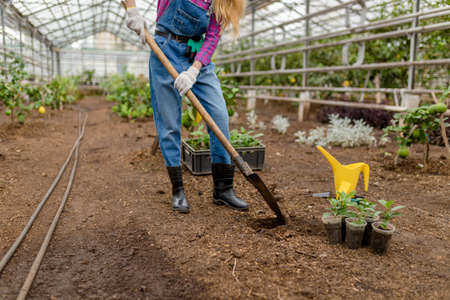1. Understanding Permaculture Principles
Permaculture is all about designing your garden in a way that works with nature, not against it. Instead of relying on chemicals or constant maintenance, permaculture encourages sustainable and regenerative practices. This approach is especially important when thinking about companion planting and crop rotation, because both techniques are rooted in working with natural systems.
Core Ethics of Permaculture
At the heart of permaculture are three main ethics that guide every decision:
| Ethic | Description |
|---|---|
| Earth Care | Protecting and nourishing the soil, water, air, and all living things. In gardening, this means using organic methods and avoiding harmful pesticides. |
| People Care | Supporting our own health and the wellbeing of our communities by growing healthy food and creating beautiful, functional spaces. |
| Fair Share | Sharing surplus with others and limiting consumption so resources can be fairly distributed. |
Key Design Principles for Garden Planning
When planning a permaculture garden that includes companion planting and crop rotation, here are some essential design principles to keep in mind:
Observe and Interact
Before you plant anything, spend time observing your space—sunlight, wind patterns, water flow, and existing plants. This helps you make better decisions about where and what to plant.
Use and Value Diversity
Diversity in the garden reduces pests and diseases while increasing resilience. Companion planting is a great example of this principle in action—pairing different plants together to support each other.
Catch and Store Energy
This can mean harvesting rainwater, composting kitchen scraps, or planting perennials that return year after year without replanting.
Use Small and Slow Solutions
Start small with simple companion pairings or a basic crop rotation plan. Over time, these small actions build into a thriving ecosystem.
Integrate Rather Than Segregate
A good garden design places plants together so they benefit one another—like marigolds deterring pests from tomatoes or beans fixing nitrogen near corn.
Produce No Waste
Everything has a purpose—even weeds can become compost! A well-designed system recycles nutrients naturally.
Biodiversity as a Foundation
Diversity isnt just about having lots of different plants—its about choosing ones that work well together. This is where companion planting shines. You’ll also want to rotate crops to avoid depleting soil nutrients or encouraging diseases tied to specific plant families.
Example: Companion Planting & Crop Rotation Working Together
| Year | Main Crop | Companion Plants | Benefits |
|---|---|---|---|
| Year 1 | Tomatoes | Basil, Marigolds | Pest control, flavor enhancement |
| Year 2 | Beans (legumes) | Corn, Cucumbers | Nitrogen fixation for future crops |
| Year 3 | Leafy Greens (e.g., lettuce) | Radishes, Carrots | Diverse root depths improve soil structure |
This kind of planning helps you create a balanced garden that supports itself—less work for you and better results for your plants.
The next step is understanding how to apply these principles specifically through companion planting strategies—pairings that help your garden thrive naturally.
2. The Science Behind Companion Planting
Companion planting is more than just a traditional gardening practice—its a science-backed strategy that supports healthy plant growth, reduces pest problems, and boosts overall garden productivity. In the context of permaculture, where sustainability and natural systems are key, companion planting plays a crucial role in creating balanced ecosystems within your garden.
How Companion Plants Work Together
Certain plants have natural properties that benefit their neighbors. Some attract beneficial insects, while others repel harmful pests. Some improve soil fertility, while others offer shade or support. By carefully choosing which plants to grow together, you can reduce the need for chemical fertilizers and pesticides.
Key Benefits of Companion Planting
| Benefit | Description |
|---|---|
| Pest Control | Plants like marigolds emit scents that deter nematodes and aphids, protecting nearby vegetables. |
| Enhanced Growth | Certain combinations, like corn and beans, improve each other’s growth by sharing nutrients and offering physical support. |
| Soil Health | Legumes fix nitrogen into the soil, enriching it for heavy feeders like tomatoes and peppers. |
| Higher Yields | Diverse planting reduces competition and stress among plants, leading to better harvests. |
Popular Companion Plant Pairings in Permaculture Gardens
In permaculture design, companion planting is used alongside other techniques like crop rotation and mulching to promote long-term soil health and resilience. Here are some well-known pairings:
| Plant A | Plant B (Companion) | Why It Works |
|---|---|---|
| Tomatoes | Basil | Basil repels tomato hornworms and may enhance tomato flavor. |
| Corn | Beans & Squash (Three Sisters) | Corn offers support for beans; beans fix nitrogen; squash shades soil to retain moisture and suppress weeds. |
| Carrots | Onions | Onions deter carrot flies with their strong scent. |
| Cabbage Family (Brassicas) | Dill & Nasturtiums | Dill attracts predatory insects; nasturtiums lure aphids away from cabbage leaves. |
The Role of Biodiversity in Pest Management
A diverse garden filled with different plant species creates an environment where pests are less likely to thrive. Many harmful insects are host-specific, so mixing crops disrupts their life cycles. At the same time, flowering herbs like cilantro and yarrow attract beneficial insects such as ladybugs and lacewings that prey on pests naturally.
Boosting Soil Fertility Through Strategic Pairing
Some plants act as dynamic accumulators, drawing nutrients from deep in the soil and making them available to neighboring plants. Others have root structures that break up compacted soil or help retain moisture. Integrating these functions into your garden layout supports the permaculture principle of stacking functions—getting multiple benefits from a single element.
Examples of Soil-Improving Companions:
| Soil Benefit Type | Example Plants | Description |
|---|---|---|
| Nitrogen Fixation | Peas, Beans, Clover | Add nitrogen to soil through symbiosis with Rhizobium bacteria. |
| Mineral Accumulation | Borage, Comfrey, Dandelion | Deep roots mine minerals and bring them closer to the surface. |
| Mild Tillage Effect | Daikon Radish, Sunflowers | Break up compacted soil with strong taproots. |
| Moisture Retention/Shade Cover | Pumpkins, Sweet Potatoes | Creeping vines cover ground to reduce evaporation. |
This natural collaboration between plants mimics what happens in wild ecosystems—plants supporting one another without human intervention. By understanding these relationships and incorporating them into your permaculture design, you can create a self-sustaining garden that thrives season after season.

3. Implementing Companion Planting in Your Garden
Companion planting is all about creating a garden community where plants support each other. In a permaculture setting, this technique helps reduce pests, improve soil health, and maximize space by mimicking natural ecosystems. When youre pairing vegetables, herbs, and flowers in your American home garden, the key is understanding which plants get along and why.
Choosing the Right Companions
Start by considering the needs and traits of your main crops. For example, tomatoes benefit from basil and marigolds nearby—not just for flavor enhancement but also for pest control. Similarly, beans fix nitrogen in the soil, which can help heavy feeders like corn grow better.
Popular Companion Planting Combinations
| Main Crop | Good Companions | Benefits |
|---|---|---|
| Tomatoes | Basil, Marigold, Carrot | Basil improves flavor; marigolds deter nematodes; carrots loosen soil |
| Corn | Beans, Squash (Three Sisters) | Beans fix nitrogen; squash suppresses weeds and retains moisture |
| Cabbage | Dill, Nasturtium, Onion | Dill attracts beneficial insects; nasturtiums act as a trap crop; onions repel pests |
| Lettuce | Radish, Chives, Calendula | Radishes break up soil; chives deter aphids; calendula attracts pollinators |
| Zucchini | Nasturtium, Borage, Peas | Nasturtiums deter squash bugs; borage attracts bees; peas enrich the soil with nitrogen |
The Role of Herbs and Flowers in Companion Planting
Aromatic herbs like rosemary, thyme, and sage can mask the scent of vulnerable vegetables from pests. Meanwhile, flowering plants such as alyssum or cosmos attract pollinators and predatory insects that help manage harmful bug populations naturally.
A Few Easy Herb Pairings:
- Basil + Tomatoes: Improves growth and repels tomato hornworms.
- Dill + Cucumbers: Attracts beneficial insects like wasps and hoverflies.
- Sage + Brassicas (e.g., broccoli): Repels cabbage moths.
Tips for Getting Started with Companion Planting
- Plan ahead: Sketch out your garden layout to ensure proper spacing and sunlight for all companions.
- Avoid bad neighbors: Some plants don’t get along—like onions and beans—so do some research before planting.
- Diversify your beds: Mix flowers and herbs into vegetable beds to create a balanced mini-ecosystem.
- Add vertical elements: Use trellises for vining plants like beans or cucumbers to make room for ground-level companions like lettuce or radishes.
- Keen observation: Watch how your plant combinations perform over time and adjust each season based on what worked well.
This practical approach to companion planting aligns with permaculture principles by promoting biodiversity and working with nature rather than against it. With thoughtful planning and observation, your garden can become more resilient, productive, and beautiful—all at once.
4. Crop Rotation for Soil Health and Pest Management
Crop rotation is a key principle in permaculture gardening that helps maintain healthy soil, reduce pest issues, and support long-term productivity. Instead of planting the same crop in the same spot year after year, rotating crops encourages a more balanced ecosystem and prevents problems before they start.
Why Rotate Crops?
Each type of plant uses and returns different nutrients to the soil. For example, leafy greens like lettuce need lots of nitrogen, while root vegetables like carrots are lighter feeders. By rotating crops, you avoid depleting the soil of specific nutrients and allow time for natural replenishment. Crop rotation also breaks pest and disease cycles by removing their preferred host plants from the area.
Basic Crop Rotation Groups
In home gardens, its helpful to group crops based on their families or nutrient needs. Here’s a simple 4-year rotation plan you can follow:
| Year | Bed 1 | Bed 2 | Bed 3 | Bed 4 |
|---|---|---|---|---|
| Year 1 | Leafy Greens (Lettuce, Spinach) | Fruit Crops (Tomatoes, Peppers) | Root Crops (Carrots, Beets) | Legumes (Beans, Peas) |
| Year 2 | Fruit Crops | Root Crops | Legumes | Leafy Greens |
| Year 3 | Root Crops | Legumes | Leafy Greens | Fruit Crops |
| Year 4 | Legumes | Leafy Greens | Fruit Crops | Root Crops |
The Role of Legumes in Soil Building
Legumes like beans and peas are especially important in crop rotation because they fix nitrogen in the soil with help from beneficial bacteria. Including legumes in your rotation naturally boosts soil fertility and reduces your reliance on fertilizers.
Pest and Disease Management Through Rotation
Certain pests and diseases target specific plant families. When you rotate those crops out of an area for a season or two, it interrupts the life cycle of those pests. For example, rotating brassicas (like cabbage or kale) helps prevent buildup of clubroot disease or cabbage worms.
A Permaculture Tip: Observe and Adapt
No garden is exactly the same, so pay attention to how your plants respond over time. Keep notes each season to track which rotations work best for your soil conditions and local climate.
Crop rotation is one of the easiest ways to create a resilient garden system that works with nature rather than against it. Over time, your soil gets healthier, your plants get stronger, and you’ll notice fewer pest issues without needing chemical solutions.
5. Designing a Permaculture-Inspired Garden Plan
Creating a garden plan that blends companion planting and crop rotation with permaculture principles might sound complicated, but it can be simple and fun when broken into steps. The goal is to build a resilient, self-sustaining system where plants work together and soil stays healthy over time.
Step 1: Map Out Your Garden Space
Start by drawing a basic layout of your garden. Include fixed features like paths, fences, compost bins, water sources, and any existing trees or structures. Group your garden beds into zones based on sunlight exposure, drainage, and how often youll access them.
Step 2: Choose Your Crops
Select vegetables, herbs, and flowers suitable for your local USDA Hardiness Zone. Think about what your family likes to eat and consider seasonal cycles—cool-season crops (like spinach or peas) versus warm-season crops (like tomatoes or squash).
Step 3: Use Companion Planting Principles
Group plants that benefit each other. Here’s a handy table of common companion pairs:
| Main Crop | Good Companions | Avoid Planting With |
|---|---|---|
| Tomatoes | Basil, Marigolds, Carrots | Cabbage, Corn |
| Carrots | Onions, Lettuce, Peas | Dill |
| Cucumbers | Nasturtiums, Radishes, Beans | Sage |
| Beans | Corn, Cucumbers, Strawberries | Onions, Garlic |
| Broccoli | Celery, Beets, Chamomile | Strawberries |
Step 4: Plan Crop Rotation Cycles
Rotate crops yearly to prevent nutrient depletion and reduce pests. A simple four-year rotation cycle works well for most home gardens:
| Year | Bed 1 | Bed 2 | Bed 3 | Bed 4 |
|---|---|---|---|---|
| Year 1 | Leafy Greens (Lettuce) | Fruit Crops (Tomatoes) | Root Crops (Carrots) | Legumes (Beans) |
| Year 2 | Fruit Crops (Tomatoes) | Root Crops (Carrots) | Legumes (Beans) | Leafy Greens (Lettuce) |
| Year 3 | Root Crops (Carrots) | Legumes (Beans) | Leafy Greens (Lettuce) | Fruit Crops (Tomatoes) |
| Year 4 | Legumes (Beans) | Leafy Greens (Lettuce) | Fruit Crops (Tomatoes) | Root Crops (Carrots) |
Step 5: Add Supportive Elements for Regeneration
Pile on the permaculture layers! Add mulch to retain moisture and suppress weeds. Use compost or worm castings to feed the soil naturally. Plant pollinator-friendly flowers like calendula or borage around vegetable beds to invite bees and beneficial insects.
Create Microclimates Where Needed
You can use trellises for climbing crops like beans or cucumbers to provide shade for heat-sensitive plants like lettuce underneath. Plant sunflowers on the west side of your garden to serve as windbreaks or natural fencing.
Your Garden Plan in Action!
You now have a roadmap for designing a garden thats not only productive but also works with nature instead of against it. By combining thoughtful companion planting and smart crop rotation with permaculture strategies, your garden can thrive season after season.


